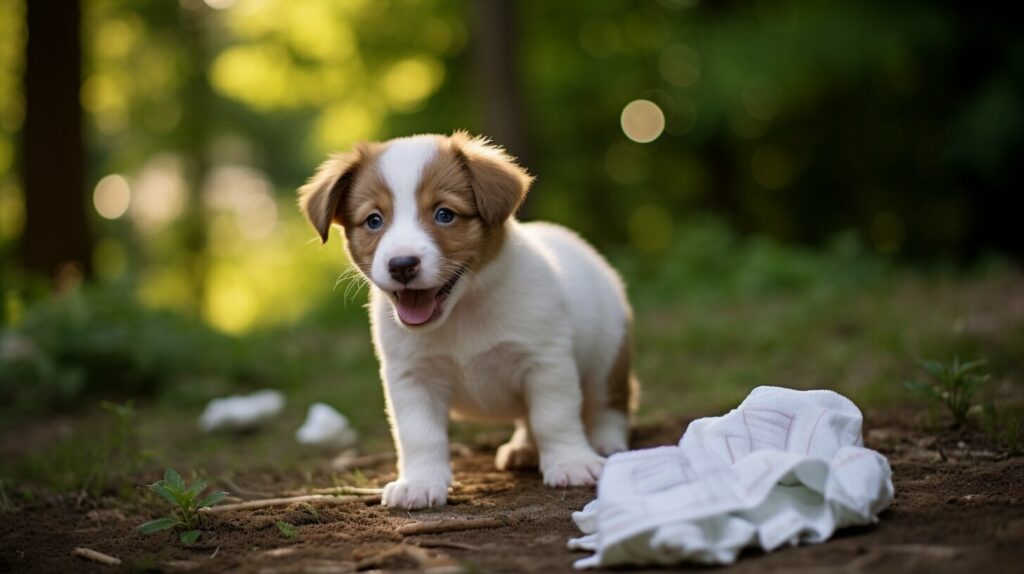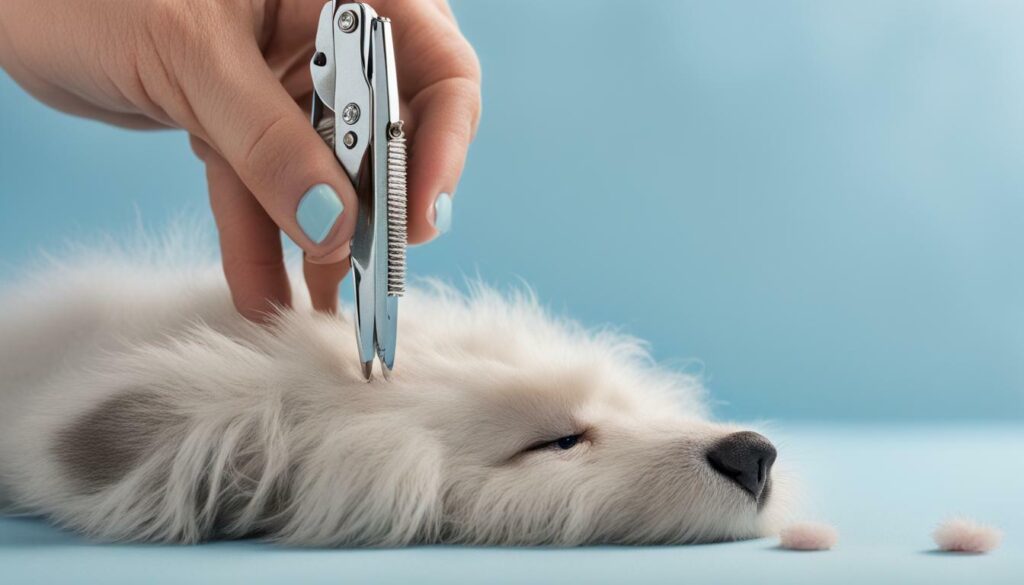If you’re a pet owner, you know that your furry friend’s health and well-being is a top priority. That’s why it’s important to be prepared for any situation that may arise, including the need for a cone. Cones for dogs can protect your pet after surgery or prevent them from aggravating an injury, but choosing the right one and introducing it to your pet can be a challenge. In this article, we will guide you through everything you need to know about cones for dogs.
Key Takeaways:
- Cones for dogs are important for protecting your pet after surgery or preventing them from licking, scratching, or biting an injury.
- There are various types of cones available including inflatable, recovery, soft, and transparent cones.
- Choosing the right cone for your pet is crucial and factors such as size and comfort should be considered.
- Introducing the cone to your dog can be a gradual process and positive reinforcement techniques can be helpful.
- Alternative options to traditional cones include inflatable cones and recovery suits.
- Challenges with cones include the “cone of shame” stigma and proper maintenance and cleaning is necessary for durability and hygiene.
Why Do Dogs Need Cones?
After surgery, your furry friend will need some extra care to recover properly. One way to ensure their safety during the healing process is to use a cone for dogs. This essential tool protects them from licking, scratching or biting at their wounds, which can cause infections or re-injury.
Post-surgery, your dog’s skin and tissue might be sensitive, and your pet’s natural instinct to groom themselves could be harmful. The cone for dogs can prevent them from doing so, allowing the wounds to heal faster.
Additionally, the cone can help with allergies, hot spots, and other skin conditions, as well as preventing your dog from eating or drinking anything that might harm their recovery process.
Types of Cones for Dogs
There are several types of cones available for dogs, each with its benefits and drawbacks. When choosing a cone for your pet, consider their size, temperament, and the purpose of the cone. Here are some of the most common types of cones:
| Type | Description | Pros | Cons |
|---|---|---|---|
| Inflatable Dog Cone | These cones look like inflatable collars and are designed to restrict your pet’s movement while still allowing them to see and eat. | More comfortable than traditional cones, less restrictive, easy to clean and store. | May not be as effective as traditional cones, not suitable for all dogs. |
| Recovery Cone for Dogs | These cones are made of hard plastic and come in various sizes. They are commonly used after surgeries to prevent dogs from scratching or licking their wounds. | Effective for wound protection, suitable for most dogs, durable. | Can be uncomfortable and restrictive, may cause stress or anxiety for some dogs. |
| Soft Dog Cone | These cones are made of soft materials like foam, fabric, or padded vinyl. They provide more comfort and flexibility compared to hard plastic cones. | More comfortable and flexible than traditional cones, suitable for dogs with sensitive skin or allergies. | May not be as effective for wound protection, may not fit securely around the neck. |
| Transparent Dog Cone | These cones are made of clear plastic and allow your pet to see their surroundings while wearing the cone. They are less restrictive than traditional cones and can be less stressful for some pets. | More comfortable and less restrictive than traditional cones, allows your pet to see while wearing the cone. | May not be as effective for wound protection, may not fit securely around the neck, may not be suitable for all dogs. |
When choosing a cone for your dog, consider their specific needs and preferences. Be sure to measure their neck size and choose a cone that fits snugly but not too tightly. Remember, the right cone can help your dog recover more quickly and comfortably.
Choosing the Right Cone for Your Dog
Choosing the right cone for your dog is essential for their well-being and comfortable recovery. When selecting a cone for dogs, there are a few key factors to consider, such as size, comfort, and effectiveness.
The cone should fit your dog snugly and allow them to move around freely. If the cone is too big or too small, it may cause discomfort or impair their movement. You can measure your dog’s neck circumference to ensure a proper fit.
It’s important to choose a cone that is comfortable for your dog to wear. Some cones come with padding or soft materials to prevent irritation and rubbing against their skin. Soft dog cones or inflatable dog cones are good options that provide the necessary protection while being more comfortable for your dog.
Consider the purpose of the cone when choosing the right type. Recovery cones for dogs have a wider base and provide better protection for the surgical site or wound. Transparent cones allow for better visibility, while soft dog cones may not be as effective in preventing them from licking or scratching themselves.
Lastly, consider any alternative options for cones for dogs. Recovery suits or inflatable cones are a good alternative to traditional cones for pets who may not adjust well to the hard plastic cone. However, it’s always best to consult with your veterinarian to determine the best cone or alternative for your dog’s specific needs.
Introducing the Cone to Your Dog
Introducing your dog to a cone can be a challenging process, but it is essential to ensure their safety and recovery. The following tips will help make the transition smoother:
Positive Reinforcement
Start by introducing the cone to your dog in a positive and gradual manner. Offer treats and praise when they approach or interact with the cone. This will help them associate the cone with positive experiences.
Gradual Introduction
Avoid forcing the cone on your dog abruptly. Instead, introduce it gradually by allowing them to sniff and inspect it. Then, place it on their head for a few minutes at a time and increase the duration gradually. This will help your dog adjust to wearing the cone without feeling overwhelmed.
Comfort during Transition
Ensure your dog is comfortable during the transition. Adjust the cone’s fit as needed to prevent discomfort or irritation. Offer soft bedding and toys to distract your dog and keep them comfortable while wearing the cone.
Remember, wearing a cone may be uncomfortable for your dog initially, but it is crucial for their safety and recovery. With patience and positivity, your dog will soon adjust to wearing a cone and heal faster.
Caring for Your Dog While Wearing a Cone
It is important to take the proper steps to care for your dog while they are wearing a cone. Here are some tips to help you during this time:
Feeding
Feeding your dog while they are wearing a cone can be a bit challenging. You may need to elevate their food and water bowls to help them reach it easily. Try to avoid giving them large amounts of food at once, and stick to smaller, more frequent meals throughout the day.
Drinking
Your dog may have trouble drinking water while wearing a cone. Try using a water bowl that is shallow and wide to make it easier for them to drink. You can also try adding ice cubes to the water, which can make it more appealing to your pet.
Grooming
Grooming your dog can be tricky while they are wearing a cone. You may need to be extra careful when brushing or trimming their fur. It can also be helpful to use a soft-bristle brush to avoid irritating their skin.
Taking Walks
Taking your dog for a walk while they are wearing a cone can be challenging, but it is important to keep them active during the healing process. Use a shorter leash to keep them close to you and avoid any potential hazards. You can also try using a harness instead of a collar, which may be more comfortable for your pet.
Monitoring Behavior
It is important to monitor your dog’s behavior while they are wearing a cone. Look for any signs of discomfort, such as excessive scratching or rubbing. If you notice any issues, contact your veterinarian right away.
By following these tips, you can help your dog feel more comfortable and supported during the healing process. Remember to be patient and give your pet plenty of love and attention during this time.
Alternatives to Traditional Cones
If you are looking for an alternative to the traditional cone collar for your dog, there are several options available.
Inflatable Cones
Inflatable cones are a great alternative to the traditional plastic cone collar. They are soft and comfortable for your dog to wear, while still providing the necessary protection. The inflatable design prevents your dog from scratching or biting at their wounds, while allowing for a wider range of movement than the traditional cone collar. Inflatable cones are also easy to maintain, as they can be deflated and stored when not in use.
Recovery Suits
Recovery suits are another great alternative to the traditional cone collar. They are designed to cover your dog’s wounds while allowing for a wider range of motion than the cone collar. Recovery suits come in a variety of sizes and styles, and offer full body coverage for your dog. They are easy to maintain and can be machine washed, making them a convenient option for pet owners.
Other Innovative Alternatives
There are several other innovative alternatives to the traditional cone collar available for your dog. These include soft cones, transparent cones, and even recovery collars that attach to your dog’s harness instead of their neck. When choosing an alternative cone for your dog, consider the level of protection they offer, as well as your dog’s comfort and mobility.
Remember, it is important to consult with your veterinarian before choosing an alternative cone for your dog. Your vet can help you determine which option is best for your dog’s specific needs and recovery process.
Overcoming Challenges with Cones
Wearing a cone can be difficult for your pet, both physically and emotionally. It may be uncomfortable, limit their mobility, and cause them to feel anxious or embarrassed. The “cone of shame” stigma can also affect your dog’s behavior and self-esteem.
However, there are several ways to help your dog overcome these challenges. First, make sure the cone fits properly and is comfortable for your pet to wear. You may need to adjust the size or padding to ensure a snug fit without causing irritation.
Second, provide your dog with positive reinforcement and support during the transition. Offer treats, praise, and affection to help them associate the cone with positive experiences. Gradually introduce the cone and allow your dog to wear it for short periods before gradually increasing the duration.
Third, consider using alternative cones or collars that are less bulky and restrictive. Inflatable or soft cones, for example, can provide similar protection without obstructing vision or hindering movement.
Finally, monitor your dog’s behavior and comfort levels while they are wearing the cone. Look for signs of distress or discomfort, such as excessive panting, whining, or restlessness. If necessary, consult with your vet or a professional dog trainer for additional guidance and support.
Maintaining Your Dog’s Cone
Keeping your dog’s cone clean and well-maintained is important for their hygiene and comfort. Here are some tips to help you care for your dog’s cone:
- Regularly wipe down the inside and outside of the cone with a damp cloth to remove any dirt or debris.
- Use a mild soap to clean the cone if necessary, and rinse thoroughly.
- Allow the cone to air dry completely before putting it back on your dog.
- Inspect the cone regularly for wear and tear, and replace if necessary.
It’s important to note that some cones are designed for one-time use only and cannot be cleaned or maintained. If this is the case with your dog’s cone, be sure to monitor its condition closely and replace it if it becomes soiled or damaged.
In addition to caring for the cone itself, it’s important to ensure that your dog is comfortable while wearing it. Check the fit of the cone regularly and adjust as needed to prevent any rubbing or irritation. If your dog is struggling to eat or drink while wearing the cone, consider using a feeding or watering bowl designed specifically for dogs wearing cones.
With proper care and maintenance, your dog’s cone can help protect them during the healing process and ensure a speedy recovery.
Conclusion
Caring for your beloved pet during their recovery period may seem daunting, but providing them with the right cone or alternative option will go a long way towards ensuring their well-being. Remember, the cone is not a punishment, but a protective measure to keep your dog from injuring themselves while they heal.
When choosing a cone, consider your dog’s size, comfort, and needs. Take the time to measure your pet and choose a cone that fits properly. Introduce the cone gradually and use positive reinforcement to help your dog adjust.
Remember, while wearing a cone, your dog will need extra care and attention. Monitor their behavior and comfort level, and make necessary adjustments. Help your pet feel comfortable by providing them with favorite toys, treats, and blankets.
Finally, if your dog has trouble adjusting to a cone, consider alternative options such as inflatable cones or recovery suits. Just remember to consult with your veterinarian before making any changes.
With a little patience and care, your dog will soon be on the road to recovery. Remember to maintain and clean the cone regularly and replace it if necessary. Most importantly, provide your pet with love and support during this time. Your furry friend will thank you for it in the end.
FAQ
Q: Why do dogs need to wear cones?
A: Dogs may need to wear cones to prevent licking, scratching, and biting at wounds and incisions, particularly after surgery.
Q: What are the different types of cones for dogs?
A: There are different types of cones available for dogs, including inflatable cones, recovery cones, soft cones, and transparent cones.
Q: How do I choose the right cone for my dog?
A: When choosing a cone for your dog, consider factors such as size, comfort, and effectiveness. It’s also important to measure your dog for a proper fit.
Q: How can I introduce the cone to my dog?
A: You can introduce the cone to your dog by using positive reinforcement techniques, gradually introducing it, and providing comfort during the transition.
Q: How do I care for my dog while they are wearing a cone?
A: While your dog is wearing a cone, you should take care of their feeding, drinking, grooming, and walks. Monitor their behavior and comfort levels as well.
Q: Are there alternatives to traditional cones for dogs?
A: Yes, there are alternative options such as inflatable cones, recovery suits, and other innovative alternatives that provide similar protection while being more comfortable for your pet.
Q: How can I help my dog feel more comfortable while wearing a cone?
A: To help your dog feel more comfortable, address the “cone of shame” stigma and provide additional support and reassurance during the cone-wearing period.
Q: How do I maintain and clean my dog’s cone?
A: To maintain and clean your dog’s cone, use proper cleaning techniques and look out for signs that indicate it may need to be replaced.



